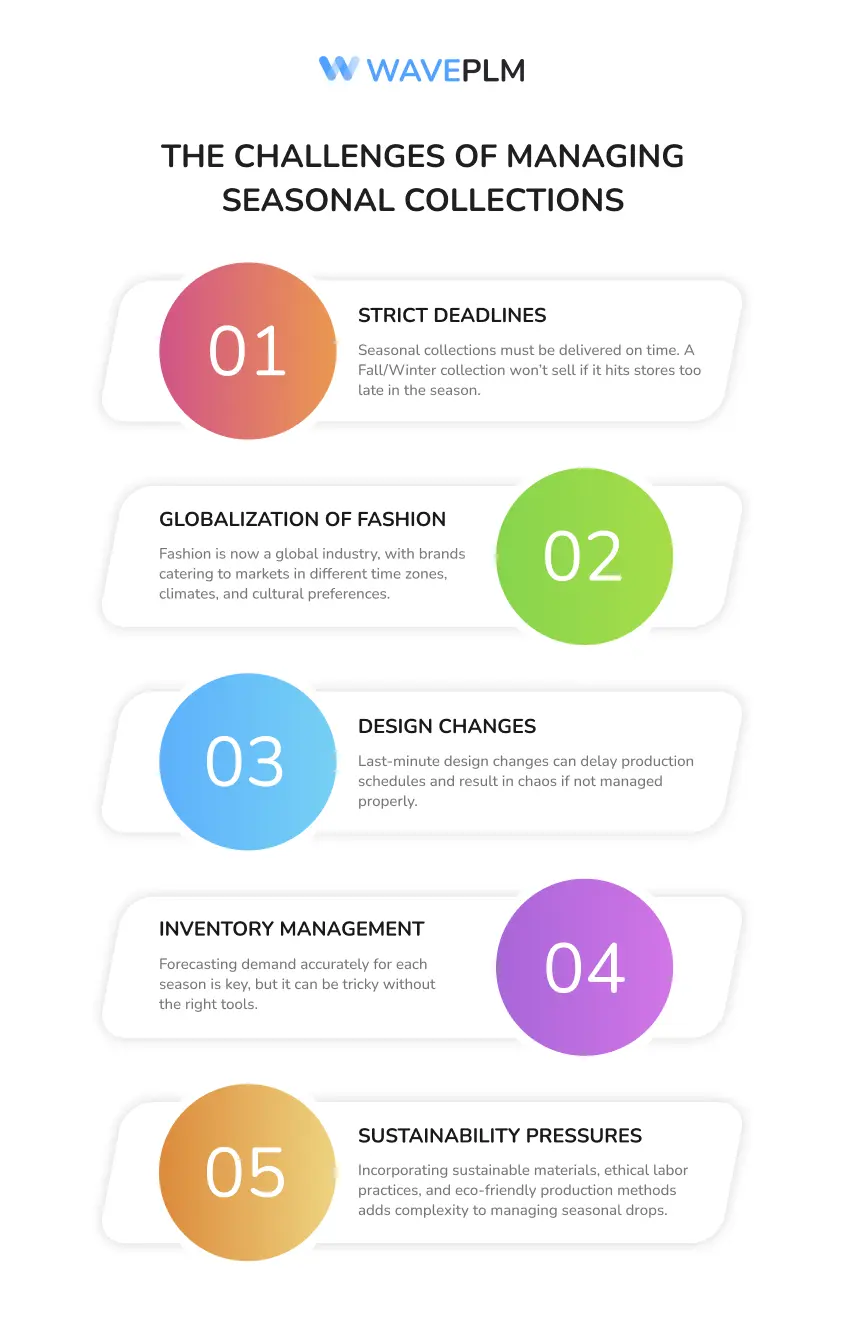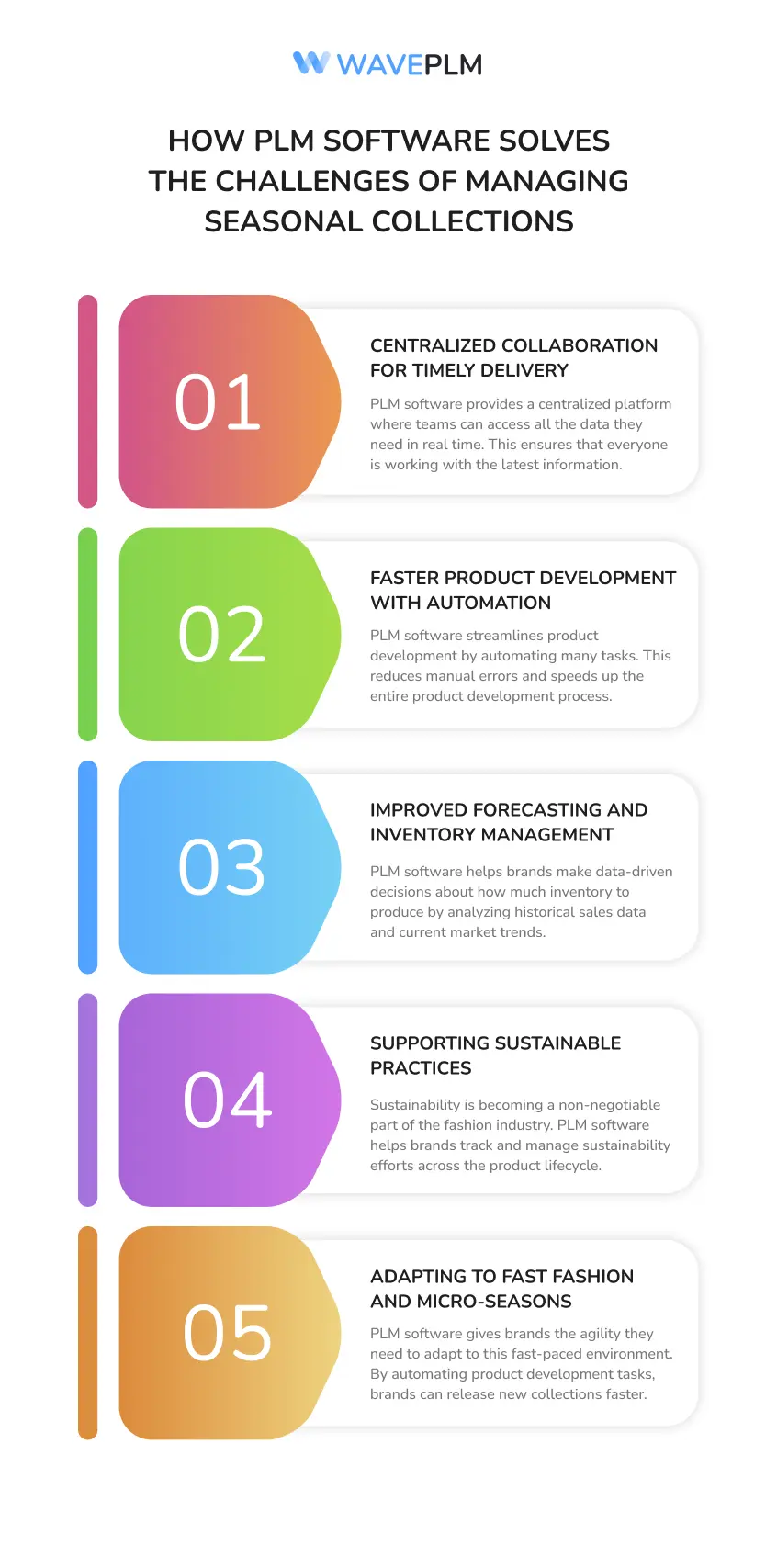
Fashion is a dynamic industry where timing is everything. Seasonal collections are planned months in advance, yet they must align with fast-changing consumer trends. The traditional fashion calendar is the backbone of how brands, designers, and retailers release their collections to the market. However, with the rise of fast fashion, shorter production cycles, and increased demand for sustainability, managing these seasonal drops has become far more complex.
In this challenging landscape, Product Lifecycle Management (PLM) software offers a powerful solution. It allows brands to streamline their processes, improve team collaboration, and deliver collections on time without compromising on quality or sustainability. In this article, we’ll explore how PLM software as a single source of truth helps brands manage seasonal drops in an increasingly competitive market, and how it can adapt to the fashion calendar.
What is the Fashion Calendar?
The fashion calendar refers to the seasonal schedule that brands follow when launching new collections. Traditionally, the fashion year is divided into two main seasons: Spring/Summer and Fall/Winter. These collections are shown to buyers and the press months before they hit stores, often during fashion weeks in cities like New York, Paris, Milan, and London.
However, the fashion calendar has evolved. Pre-season collections, such as Resort and Pre-Fall, have added additional layers to the yearly schedule. For instance, Resort collections are typically launched in November or December, just before the main Spring/Summer lines, while Pre-Fall collections are showcased in early summer, preceding the Fall/Winter lines.
On top of these traditional collections, the rise of fast fashion and direct-to-consumer brands has led to the introduction of micro-seasons. Some brands release new styles almost every week, drastically shortening the time between design and retail.
The Challenges of Managing Seasonal Collections
Managing seasonal drops is not just about sticking to the fashion seasons calendar. It requires precise coordination between design, production, marketing, and retail teams. Here are the most common challenges brands face when managing seasonal collections:
- Strict Deadlines: Seasonal collections must be delivered on time. A Fall/Winter collection won’t sell if it hits stores too late in the season. Missing deadlines can result in missed sales opportunities, markdowns, or even cancelled orders from retailers.
- Globalization of Fashion: Fashion is now a global industry, with brands catering to markets in different time zones, climates, and cultural preferences. A collection designed for the European winter may not align with the needs of the Southern Hemisphere. Brands must manage multiple timelines and design variations to cater to a global audience.
- Design Changes: Fashion trends evolve rapidly. Last-minute design changes can delay production schedules and result in chaos if not managed properly. Without an efficient system, even small changes can cause disruptions across the supply chain management.
- Inventory Management: Producing the right amount of inventory is critical for profitability. Too much stock leads to waste and markdowns, while too little stock results in missed sales. Forecasting demand accurately for each season is key, but it can be tricky without the right tools.
- Sustainability Pressures: Consumers and regulators are demanding more sustainable practices from fashion brands. Incorporating sustainable materials, ethical labor practices, and eco-friendly production methods adds complexity to managing seasonal drops.
How PLM Software Solves These Challenges
PLM software is a comprehensive apparel management tool designed to help fashion brands manage every aspect of the product lifecycle, from initial concept to final product delivery. By centralizing data and streamlining processes, PLM software provides a solution to the challenges of managing seasonal collections. Let’s dive into how PLM software addresses these key challenges.
1. Centralized Collaboration for Timely Delivery
In fashion, collaboration is key. Design, production, merchandising, and marketing teams need to stay aligned to ensure that collections are delivered on time. PLM software provides a centralized platform where teams can access all the data they need in real time. This ensures that everyone is working with the latest information and reduces the risk of miscommunication.
For instance, if a design is updated, that change is instantly reflected across the platform. The production team can adjust their work accordingly, while the marketing team updates their campaigns. This level of visibility helps brands avoid delays caused by outdated information or missed communication.
Additionally, PLM software offers built-in timelines and project management tools. Teams can set deadlines, assign tasks, and track the progress of each collection in real time. This ensures that everyone stays on schedule and that potential bottlenecks are addressed early.
2. Faster Product Development with Automation
In the past, designing and developing a new collection was a time-consuming process. Designers would create sketches, which would then be sent to pattern makers, manufacturers, and other stakeholders. This process involved a lot of back-and-forth communication, which could lead to delays.
PLM software streamlines this process by automating many of these tasks. For instance, once a designer uploads a new product design, it can be automatically shared with all relevant teams. The pattern-making team can begin work immediately, and manufacturers can start sourcing materials. This reduces manual errors and speeds up the entire product development process.
For brands that release multiple collections per year, or operate on shorter production cycles, this increased speed is essential. PLM software helps brands move from concept to production faster than ever before.
3. Improved Forecasting and Inventory Management
One of the biggest challenges in managing seasonal collections is predicting demand. Producing too much or too little stock can hurt a brand’s bottom line. PLM software helps brands make data-driven decisions about how much inventory to produce by analyzing historical sales data and current market trends.
With PLM system, brands can create more accurate demand forecasts. The software can pull in data from past seasons, allowing teams to see which products performed well and which didn’t. This helps brands make informed decisions about how much stock to produce for each seasonal drop.
Additionally, PLM software can integrate with other systems, such as ERP (Enterprise Resource Planning) software, to provide a complete view of inventory and sales data. This allows brands to adjust production in real time based on actual sales performance.
4. Supporting Sustainable Practices
Sustainability is becoming a non-negotiable part of the fashion industry. Consumers are increasingly demanding transparency and eco-friendly practices from brands. PLM software helps brands track and manage sustainability efforts across the product lifecycle.
For example, brands can use PLM software to source sustainable materials and track their certifications. The software also helps brands monitor the environmental impact of their supply chain, from carbon emissions to water usage. By centralizing all of this data, PLM software enables brands to make informed decisions about sustainability.
In addition, PLM software can help brands track the lifecycle of a product even after it’s sold. For example, brands can gather data on how products are used, returned, or recycled. This information helps brands make more sustainable choices in future collections.
5. Adapting to Fast Fashion and Micro-Seasons
The rise of fast fashion has disrupted the traditional fashion calendar. Brands like Zara and H&M release new styles on a weekly basis, forcing other brands to adapt. While traditional fashion houses may still operate on the Spring/Summer and Fall/Winter schedule, they are also releasing more frequent “drops” to stay competitive.
PLM software gives brands the agility they need to adapt to this fast-paced environment. By automating product development tasks and improving collaboration, brands can release new collections faster. They can also track the performance of each collection in real time and use that data to refine future fashion designs.
For brands that want to release smaller, more frequent collections, PLM software provides the structure and tools needed to manage these micro-seasons. This ensures that brands can keep up with consumer demand without overextending their resources.
The Fashion Calendar for 2025
As we look ahead to 2025, the fashion calendar continues to evolve. While the traditional Spring/Summer and Fall/Winter seasons remain, we’re seeing a rise in seasonless fashion and more emphasis on sustainability.
Here are some key trends shaping the fashion calendar in 2025:
- Seasonless Fashion: More brands are moving away from rigid seasonal schedules and embracing seasonless collections. This allows them to release products that are relevant year-round, rather than focusing on specific seasons. PLM software helps brands track the performance of these seasonless collections and adjust their designs based on consumer demand.
- Sustainability at the Forefront: Sustainability is a top priority for both consumers and brands. In 2025, we’ll see even more emphasis on using eco-friendly materials, reducing waste, and implementing circular fashion practices. PLM software enables brands to track their sustainability goals and ensure that their seasonal drops align with these values.
- Technology Integration: The fashion industry is increasingly integrating technology into the design and production process. From 3D design tools to virtual fashion shows, technology is transforming how collections are developed and marketed. PLM software is at the heart of this digital transformation, providing the infrastructure needed to manage these new technologies.
- Shorter Production Cycles: As consumers demand faster access to new styles, brands will continue to shorten their production cycles. PLM software helps brands stay competitive by automating product development, improving communication, and enabling faster decision-making.
Conclusion
The fashion industry is evolving, and managing seasonal collections is more challenging than ever. As brands navigate the fashion calendar for 2025, they need tools that provide speed, agility, and sustainability. PLM software offers a solution that helps brands manage every aspect of the product lifecycle, from design to retail delivery.
By improving collaboration, speeding up product development, enhancing forecasting, and supporting sustainable practices, PLM software empowers brands to stay ahead of the competition. Whether a brand is operating on a traditional seasonal schedule or adapting to fast fashion’s micro-seasons, PLM software ensures that collections are delivered on time and in line with consumer expectations.
As we move into 2025, adopting PLM software is not just a competitive advantage — it’s essential for success in the modern fashion industry.







Leave a Reply